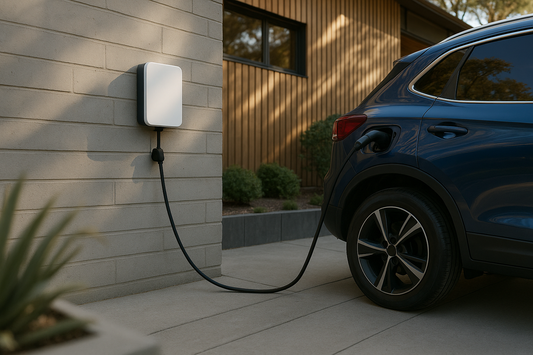The global transition to electric vehicles (EVs) has gained significant momentum, and 2024 has been a landmark year for Australia in this movement. With record-breaking EV sales, an expanding variety of models, and a robust push toward cleaner energy, Australia is positioning itself as a key player in the global EV market. Central to this progress is the New Vehicle Efficiency Standard (NVES), set to take effect in 2025. In this article, we explore the advancements made in 2024 and the transformative potential of the NVES for Australia’s automotive landscape.
Highlights of Australia’s 2024 EV Market
The year 2024 has been pivotal for EV adoption in Australia, showcasing record-breaking progress in EV sales, infrastructure, model availability, and state-level policy goals. These advancements underscore Australia’s growing commitment to a sustainable transport future and its alignment with global trends in electrification.

1. Record-Breaking EV Sales
By the end of September, Australians had purchased over 100,000 EVs, setting a new benchmark and marking a 13% increase in market share from 2023. EVs now account for 9.5% of all new vehicle sales, reflecting growing consumer interest in sustainable and cost-efficient transportation.

2. Top-Selling EV Models
The surge in EV sales was driven by a combination of new model launches and the continued popularity of established favorites. The Tesla Model Y led the market with 20% of total EV sales (16,697 units). Other top performers include:
- Tesla Model 3: 14,053 units sold, renowned for its sleek design and advanced features.
- BYD Atto 3: 5,308 sales, celebrated for its compact design and affordability.
- BYD Seal: 4,926 units, blending performance with cost-effectiveness.
- Mitsubishi Outlander PHEV: 4,438 sales, offering versatility as a plug-in hybrid.

3. Expanding EV Model Availability
Australia’s EV market now features 122 models, including 78 battery electric vehicles (BEVs) and 44 plug-in hybrid electric vehicles (PHEVs). This 50% increase in model availability compared to 2023 provides diverse options for consumers, whether they need a family SUV, a city-friendly compact car, or a hybrid solution for longer journeys.
4. Infrastructure Milestones
Charging infrastructure saw significant growth in 2024, with over 1,000 high-power public charging locations nationwide—a 90% increase from the previous year. This includes fast and ultra-fast charging stations, making EV ownership more convenient across urban and regional Australia.

5. States’ Goals and Progress
Individual states and territories made strides toward increasing EV adoption:
- The Australian Capital Territory (ACT) leads with 25.1% of new car sales being EVs.
- Other states, including New South Wales, Queensland, and Victoria, are implementing strategies and policies to align with national emission reduction goals.
- Policy efforts, such as tax incentives and state-led infrastructure investments, continue to drive momentum.
 Looking at these achievements collectively, 2024 has been a year of remarkable progress for Australia’s EV market. The combination of record-breaking sales, diverse model availability, expanding infrastructure, and proactive state-level goals demonstrates a country firmly on the path to sustainable transportation. While challenges remain, such as policy consistency and infrastructure equity, the current trajectory signals a bright future for EVs in Australia. This solid foundation sets the stage for transformative policies like the New Vehicle Efficiency Standard (NVES), ensuring that the momentum gained in 2024 is carried forward into an even more promising future.
Looking at these achievements collectively, 2024 has been a year of remarkable progress for Australia’s EV market. The combination of record-breaking sales, diverse model availability, expanding infrastructure, and proactive state-level goals demonstrates a country firmly on the path to sustainable transportation. While challenges remain, such as policy consistency and infrastructure equity, the current trajectory signals a bright future for EVs in Australia. This solid foundation sets the stage for transformative policies like the New Vehicle Efficiency Standard (NVES), ensuring that the momentum gained in 2024 is carried forward into an even more promising future.
The New Vehicle Efficiency Standard (NVES): A Game-Changer for 2025
Amidst this momentum, the New Vehicle Efficiency Standard (NVES) stands out as a landmark policy set to reshape Australia’s automotive landscape. Scheduled to take effect in 2025, the NVES is designed to reduce vehicle emissions, increase EV availability, and make low-emission vehicles more accessible to Australian consumers.

Why NVES Matters
Australia’s transport sector is one of the largest contributors to national emissions, accounting for approximately 20% of the total carbon footprint. As other sectors, such as energy, decarbonize, transport emissions are expected to become the leading source of greenhouse gases. The NVES directly addresses this challenge by setting emission reduction targets for new vehicles, encouraging automakers to prioritize low- and zero-emission models.
For Australian consumers, this translates into greater choice and affordability. By aligning with global standards, the NVES incentivizes manufacturers to introduce a wider range of EVs into the Australian market, including models that have previously been unavailable due to regulatory or economic barriers. This policy will also help reduce dependence on imported oil, shielding Australians from the volatility of global fuel markets and driving down transportation costs.
Key Benefits of NVES
- Enhanced Model Availability: The NVES will push automakers to supply more affordable and diverse EV models, catering to the needs of different demographics and use cases. This is crucial for achieving broader adoption across urban, suburban, and rural areas.
- Emission Reductions: With transport emissions on the rise, the NVES plays a critical role in Australia’s goal to achieve net-zero emissions by 2050. By accelerating the transition to EVs, the policy will significantly cut emissions from light vehicles, which currently dominate the sector’s carbon footprint.
- Lower Fuel Costs: The average Australian drives approximately 40 kilometers per day, with those in regional areas covering even greater distances. Switching to EVs under the NVES framework will save drivers thousands of dollars annually on fuel and maintenance.
- Economic Opportunities: The NVES presents a chance to develop domestic industries, including EV manufacturing, battery production, and recycling. These initiatives can create jobs and position Australia as a leader in the global EV value chain.
Future-Proofing the Transition
To maximize the impact of the NVES, complementary policies and infrastructure investments will be essential. This includes expanding public charging networks, supporting residential and multi-dwelling charging solutions, and providing financial incentives for EV adoption. As of mid-2024, Australia has over 1,000 high-power public charging locations, a 90% year-on-year increase. Continued investment in charging infrastructure will ensure that EV ownership is viable for all Australians, regardless of their living situation.
Conclusion
The year 2024 has marked a turning point for Australia’s electric vehicle market. With record-breaking sales, an expanded range of models, and significant progress in charging infrastructure, the country is well on its way to embracing a cleaner and more sustainable future. The introduction of the New Vehicle Efficiency Standard in 2025 promises to accelerate this transition by reducing emissions, enhancing model availability, and lowering costs for consumers.
However, the journey is far from over. Sustained collaboration between governments, industries, and communities will be vital to address remaining challenges, such as infrastructure gaps and misinformation. As Australia gears up for this new era of transportation, the NVES stands as a beacon of progress, guiding the nation toward a greener, more resilient future.



